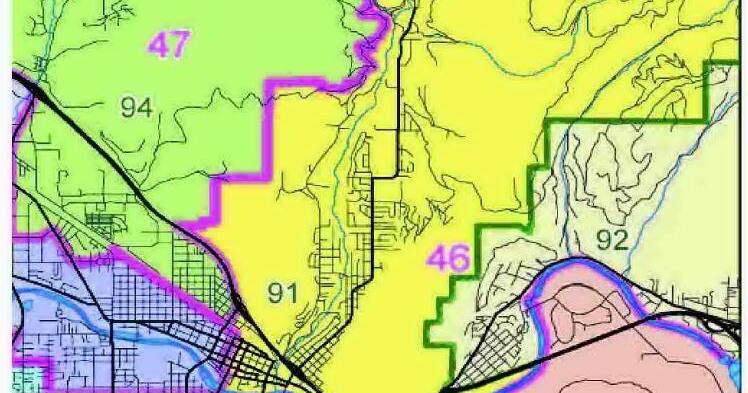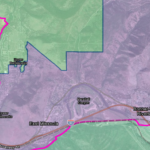Pineview Drive ends abruptly at a stand of tall ponderosa pine trees and the trickle of Rattlesnake Creek.
In the heart of Missoula’s Rattlesnake neighborhood, this is where three Montana state House districts come together, each stretching out dozens of miles into rural communities.
Previously in a single voting district, the Rattlesnake’s three new districts are the result of a redistricting process by the Montana Legislature in 2023.
The new Montana state House and Senate maps are being used for the first time in the November election. House District 91, House District 92 and House District 99 each have a pie piece of the Rattlesnake.
House District 91 includes the Upper Rattlesnake and crosses the Rattlesnake Mountains into Arlee and Ronan.
People are also reading…
House District 92 goes from the Lower Rattlesnake to the east side of Missoula County, including East Missoula and Condon. House District 99 stretches from the west of Rattlesnake Creek into Grant Creek and the Wye.
Two Senate seats — District 46 and District 50 — also fall in the Rattlesnake, but only District 46 has an election this fall. Candidates running for seats in those districts said they are not only trying to win the Rattlesnake’s vote, but also need to make their case to the more rural voters they would now represent under the new boundaries.
Long drives on the campaign trail across the new districts have shown some issues transcend geographic distances, like property taxes. But there’s also been a learning curve to making your case in new communities.
“It’s a big switch, but it is still a great opportunity to represent Montanans,” said Connie Keogh, a three-term Democratic House representative for the Rattlesnake, who is now also running to represent East Missoula and Condon.
Candidates look to urban, rural policies
Of the three districts in the Rattlesnake, House District 91 likely has the most ground to cover. The district includes the Upper Rattlesnake, Arlee, Ronan and some parts of Sanders County like Camas Prairie.
Shelly Fyant, the district’s Democratic candidate, said she focused much of her campaign time door-knocking in the Rattlesnake neighborhood.
As the previous chairwoman for the Confederated Salish and Kootenai Tribes, Fyant said she is well-known to the tribal members on the Flathead Reservation, so her goal was to reach those in Missoula and Sanders County.
This is her first time running for Legislature.
“No two counties are the same, but many have the same issues,” Fyant told the Missoulian. “It’s about protecting Montana values, which is about preserving the environment, but also being prepared for growth.”
She said there is a lot of driving involved, especially getting to the Rattlesnake from her home in Arlee.
House District 91 Republican candidate David Passieri said he was not interested in answering questions from the Missoulian.
Keogh, in District 92, previously represented the entire Rattlesnake neighborhood, which was entirely in House District 91 pre-redistricting. She held that seat for six years.
This fall, she’s running to represent the lower east Rattlesnake, East Missoula, Bonner and Condon. To make way for Rattlesnake residents, Seeley Lake was moved into a different district with Deer Lodge and Philipsburg.
Keogh told the Missoulian that she still finds the same concerns of property taxes and housing in more rural areas, but has also focused on the small-town issue of one-room schoolhouses across northeast Missoula County.
“Frankly, some policies from last session did not help our rural schools,” Keogh said, citing new rules around district reimbursements for isolated students who attend school in another district from where they live. “They are behind the eight ball on this.”
Keogh said she feels comfortable talking about this as someone who grew up on a ranch near Red Lodge, where she said she learned in a small school with a graduating class of 20.
She has been campaigning in more rural areas, including camping at Placid Lake to save time on the drive from Missoula, she said.
“It’s still an incredible opportunity to talk about issues that people care about, like conservation and agriculture,” Keogh said.
Ted Morgan, the Republican candidate for House District 92, said he has often found himself campaigning in the Rattlesnake while also focusing his time in Potomac and East Missoula.
Morgan is a Condon resident, an unincorporated town of about 300 people at the northeast edge of HD 92. Morgan told the Missoulian he’s found the same issue comes up when knocking doors in both Condon and the Rattlesnake: Property taxes.
“We are all residents of Missoula County when we are voting in this election, so I am hitting those bipartisan issues,” Morgan said. “Through my time campaigning and going doorto-door, I’ve found similarities with East Missoula and Condon.”
He said he is focused on local government and municipality law, citing concerns over annexation of East Missoula and larger issues of growth. In the Rattlesnake, he said the focus has been on aff ordability.
A Republican has won House District 92 for the last eight years, but that district included historically Republican-leaning Seeley Lake. Without it, the district could swing back to the Democrats.
Morgan said the change to add the Rattlesnake has been frustrating, as geographically, Seeley Lake has greater connectivity with Condon.
Seeley Lake and Condon share a high school, but not a House district, Morgan said.
“Our prior districting up until last year was a lot more representative of certain areas,” Morgan said. “HD 92 for the past redistricting was all our rural areas; it was all outside the city of Missoula.”
House District 99 Democrat candidate Tom France, a Democrat who previously represented House District 95, said he has been door-knocking all neighborhoods in his district, which includes some of Missoula’s Northside.
“I have spent a lot of time knocking doors in the Harry Potter neighborhood,” France said, referencing the homes on streets named after the book and movie series.
He said it has taken time to get used to the new districts, but stressed that per the state constitution, the process repeats itself every 10 years.
“By 2026, everybody will not remember the old districts,” France said.
House District 99 Republican candidate Ryan Darling did not respond to multiple requests for comment.
Rattlesnake’s many districts
The new districts are not only a representation of population growth in western Montana but also the political nature of Montana’s redistricting process.
Representation in the Rattlesnake — and every other Montana neighborhood — can change every 10 years based on new maps formed by the state redistricting commission.
The maps were created by a five-person Districting and Apportionment Commission, which included two Republicans, two Democrats and an appointment from the Montana Supreme Court.
Districts must be the same size of roughly 10,500 residents, aim to keep natural boundaries and have a level of compactness, which is not easy in a largely rural state.
Past districts have combined the Rattlesnake and Seeley Lake, or kept the Rattlesnake in a single district, also including some of downtown Missoula. The Rattlesnake’s 2020 Census population, used for the new district, was about 8,500 people, making it too small for one district on its own.
Supreme Court appointment Maylinn Smith ultimately went with the map closest to what was proposed by Democrats on the commission.
Lee Banville, director of the University of Montana School of Journalism, told the Missoulian that a variety of interests are at play during the redistricting process, including looking at keeping some seats safe for a certain party, trying to protect incumbents in the district, or creating geographical compactness.
In the case of the Rattlesnake, spreading out the urban core into other communities could make the seats less safe for Democrats, but the neighborhood has a higher impact, he said.
“By redistricting it so that you have a chunk of those voters mixed in with a chunk from Condon or a chunk from Potomac, that makes those districts less safe,” Banville said. “But if that is a Democratic core, that core is sort of being spread out across multiple districts and will aff ect the vote in three districts as opposed to one.”
Daniel Stusek, a commissioner appointed by the Republicans involved in the redistricting process, argued the change involving the Rattlesnake and other districts across Montana would likely benefit Democrats.
He said the Democrat maps have more combinations of rural and urban voters.
“In the case of the Rattlesnake, you now have 1,800 or so people from a certain neighborhood that are now in a district with 9,000 people that aren’t realistically connected to them,” Stusek said.
However, Stusek noted that the changes were needed because of the increasing population of western Montana cities.
Census data shows Montana grew by 9.6% from 2010 to 2020. Places like Gallatin County increased by 33%, while eastern Montana’s Rosebud County lost 10% of its population.
“There’s no doubt that Missoula and Bozeman have grown over the last 10 years,” Stusek said.
Stusek argued the new map does not favor Republicans, because there is already a Republican majority of voters in the state. He estimated the new map will flip seven Republican seats to Democrat.
Kendra Miller, a Democrat commissioner who worked on the new maps, did not respond to a request for comment from the Missoulian.
For voters getting their ballots for the 2024 election, Banville said the new districts notably create new conversations from the candidates and could reshape the state Legislature.
While some incumbents are still running for election, many must talk to diff erent voters than they previously did in other elections, he said.
“Voters are going to have to make new decisions, they are going to be facing new people that they have never heard before, or they are going to meet these people while the are campaigning,” Banville said. “It is an opportunity for that conversation to get reinvigorated, because they are not hearing from the same person that they have been hearing from for the last four years.”
The election is set for Nov. 5. To check what House district you are in, go online to the voterportal.mt.gov for registration status, ballot status, candidates and more.
Griff en Smith is the local government reporter for the Missoulian.





